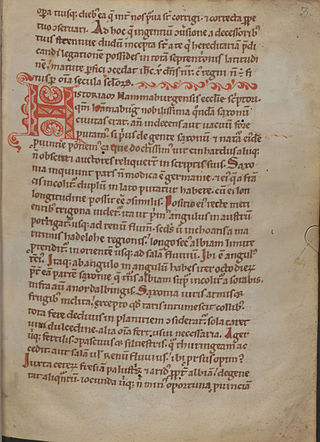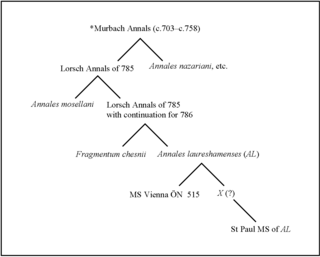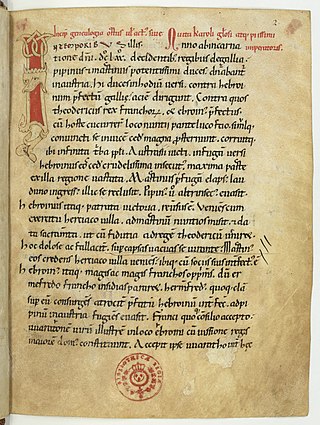
Regino of Prüm or of Prum was a Benedictine monk, who served as abbot of Prüm (892–99) and later of Saint Martin's at Trier, and chronicler, whose Chronicon is an important source for late Carolingian history.

Lorsch Abbey, otherwise the Imperial Abbey of Lorsch, is a former Imperial abbey in Lorsch, Germany, about 10 km (6.2 mi) east of Worms. It was one of the most important monasteries of the Carolingian Empire. Even in its ruined state, its remains are among the most important pre-Romanesque–Carolingian style buildings in Germany.

The Royal Frankish Annals, also called the Annales Laurissenses maiores, are a series of annals composed in Latin in the Carolingian Francia, recording year-by-year the state of the monarchy from 741 to 829. Their authorship is unknown, though Wilhelm von Giesebrecht suggested that Arno of Salzburg was the author of an early section surviving in the copy at Lorsch Abbey. The Annals are believed to have been composed in successive sections by different authors, and then compiled.

The Annales Fuldenses or Annals of Fulda are East Frankish chronicles that cover independently the period from the last years of Louis the Pious to shortly after the end of effective Carolingian rule in East Francia with the accession of the child-king, Louis III, in 900. Throughout this period they are a near contemporary record of the events they describe and a primary source for Carolingian historiography. They are usually read as a counterpart to the narrative found in the West Frankish Annales Bertiniani.

Gesta Hammaburgensis ecclesiae pontificum is a historical treatise written between 1073 and 1076 by Adam of Bremen, who made additions (scholia) to the text until his death . It is one of the most important sources of the medieval history of Northern Europe, and the oldest textual source reporting the discovery of coastal North America.
The Annales Vedastini or Annals of St-Vaast are a series of annals written in the early tenth century at the Abbey of St. Vaast in Arras. They are an important source for the ninth century. The years from 874 to 900 are covered with a strong bias for Lotharingian and West Frankish affairs. Like the Annales Fuldenses and Annales Bertiniani, the AV, as it is often abbreviated, was combined with the other Reichsannalen in the so-called Chronicon Vedastinum, a general chronicle covering the history of the Carolingian Empire up until 899.
The Reichsannalen are a class of annals composed anonymously in the Carolingian Empire throughout the 9th century. They first appeared under Pepin the Short in 741 and became ubiquitous at monasteries throughout the empire in the following decades. They were not official court annals, but they often bear the bias of having been written in one regnum or another.
The Annales iuvavenses or Annals of Salzburg are several series of annals written in Latin covering the 8th through 10th centuries. Their origin lies in Salzburg in the duchy of Bavaria. They are among the minor Frankish annals. The original version is lost but four derivatives are found in three manuscripts and additional excerpts in a fourth.

The Annals of Quedlinburg were written between 1008 and 1030 in the convent of Quedlinburg Abbey. In recent years a consensus has emerged that it is likely that the annalist was a woman. The annals are mostly dedicated to the history of the Holy Roman Empire; they also contain the first written mention of the name of Lithuania ("Litua"), in a description of an event dated to March 1009. The original document has disappeared, surviving only as a 16th-century copy held in Dresden, but its contents endure as a scholarly resource.

The Annales laureshamenses, also called Annals of Lorsch (AL), are a set of Reichsannalen that cover the years from 703 to 803, with a brief prologue. The annals begin where the "Chronica minora" of the Anglo-Saxon historian Bede leaves off—in the fifth year of the Emperor Tiberios III—and may have originally been composed as a continuation of Bede. The annals for the years up to 785 were written at the Abbey of Lorsch, but are dependent on earlier sources. Those for the years from 785 onward form an independent source and provide especially important coverage of the imperial coronation of Charlemagne in 800. The Annales laureshamenses have been translated into English.
Annales Laurissenses, meaning "annals of Lorsch", may refer to either of two sets of Reichsannalen associated with the Abbey of Lorsch:

The Fragmentum (annalium) chesnii or chesnianum, sometimes called the Annales Laureshamenses antiquiores, is a brief set of Reichsannalen describing the history of Francia during the years 768 to 790. It is named after André Duchesne, who first edited and published it in his book Historiae Francorum scriptores (1:21–23) in 1636. It has been re-edited by Georg Heinrich Pertz for the Monumenta Germaniae Historica, Scriptores I, 30–34.
In the Battle of Bornhöved or, possibly *Vir·Gento·Vedo, on the field of Sventanafeld near the village of Bornhöved near Neumünster in 798 the Obodrites, led by Drożko, allied with the Franks, defeated the Nordalbingian Saxons.
The Annales sancti Amandi (maiores) are a set of imperial Frankish annals composed in Latin in the 8th and 9th centuries at the Benedictine monastery of Saint-Amand-les-Eaux. They share text with the related Annales Tiliani, Annales Laubacenses and Annales Petaviani, all originating in monasteries of the region of Belgica and having terse, somewhat sporadic entries. The Annales sancti Amandi was preserved in a now lost manuscript that also contained Bede's De ratione temporum. This manuscript was copied in 1638 by André Duchesne, and his copy is the one upon which all subsequent editions are based.
The Chronicon Aquitanicum is a set of annals covering the years 830 to 930 with several gaps and an added notice on the year 1025. It is found in the "great encyclopedia codex", BN lat. 5239, of the Abbey of Saint Martial at Limoges. Its entries are annotations on an Easter cycle.
The Historia Francorum Senonensis is a short anonymous Latin chronicle of the Frankish kings from 688 down to 1015. It was written at Sens before 1034 and is hostile towards the Capetian dynasty that had taken the throne of West Francia in 987. It was a popular and widely used text, and its anti-Capetian view is largely responsible for the questions raised by many later authors concerning the dynasty's legitimacy.

The Chronicon universale usque ad annum 741 is an anonymous Latin chronicle from the creation of the world to AD 741. It was written in Francia, probably in Burgundy, between 741 and 775. It survives wholly or partially in at least six manuscripts.

The Chronicle of Aniane is an anonymous Latin history covering the rise of the Carolingian family from 670 to 840. It was composed by a monk of the Abbey of Aniane (Hérault).
The Chronicon Wormatiense is a fragmentary anonymous Latin chronicle of the city of Worms, Germany. It was probably composed in the last quarter of the 13th century. There is an English translation by David Bachrach.
The Annales Tiliani are an anonymous set of Latin annals from the Frankish kingdom, covering the years 708–807. They are considered minor annals.










